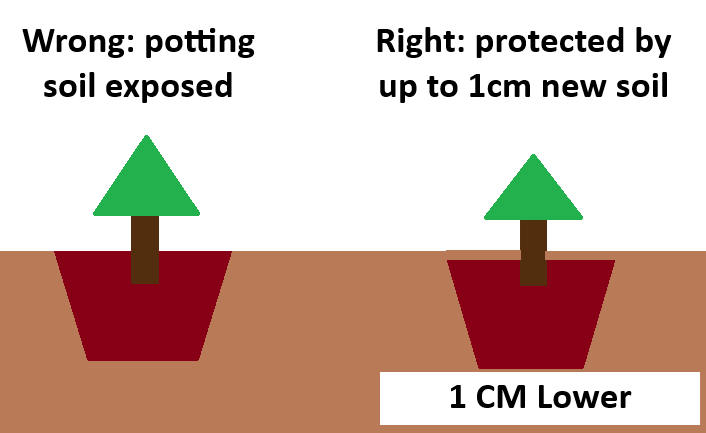After you plant a potted plant like Lavender out in your garden or a larger container, the top of the potting soil should not be visible.
The rootball should be covered by a thin layer of the new soil, no more than 1 centimetre.
That 1cm is not including mulch, which is mainly spread over the immediate area.

Don’t worry about soil getting close to the trunk at this minor depth, one centimetre is not enough to damage the trunk.
To be clear:
- Up to 1cm of soil piled against the base of a young woody plant’s trunk is no problem.
- 10cm of soil piled against the base of a young woody plant’s trunk is likely to kill the trunk and often the new plant. The exceptions can set new roots from mature wood, e.g. rose bushes, buddleja, and elder can all be planted deep.
Burying a potted plant’s rootball properly:
- Keeps the sun and wind off, like a jacket against water loss.
- Releases a small trickle of nutrients when watered, washing local soil particles down onto the roots, which is what roots like.
- Gives soil life a surface to live under, right on top of the rootball. Soil life lives underground, studies show.
- Can’t hurt with stabilizing tall plants a little against wind rock, but obviously not a replacement for a support stake.
This Means That Classic Planting Advice is Off By One Centimetre
We have repeated this advice ourselves:
“Plant a potted plant in a hole the same depth as the rootball. Don’t bury too deep!”
The Old Me, Poor Innocent
The perfect planting hole is one centimetre deeper than the rootball is tall, so when you sweep the local soil over it, it’s flush, not raised, which would shed water, and to an extent mulch if there is enough of a mound.
Thanks for Telling Me, Now I Have to Replant My Plants
Do not replant your plants! Just mulch them and they will be fine.
Note About Rain and Planting Depth
Gardening is all context: what do you want to achieve, what are your local growing conditions, and what mulch is available, if any?
- If your soil is wet through the year, you might make ridges and mounds for planting into, so the base of the rootball is sitting on top of the native soil.
If mulching, ideally use a mix of whatever organic matter with gravel and/or sharp sand to hold less moisture. - If your site is really dry and/or free draining, you might plant into a 2-inch depressions, so the surround soil forms the rim of a little bowl to catch rain.
Mulch is recommended, ideally woodchips or grass clippings. Manure is good too: horse, pig, rabbit and chicken must be composted, ruminant manure like cow and sheep can be fresh.
Finally: Watering
New plants all need watering in dry weather, even if they are drought tolerant when established.
When watering most new plants with a hose or drip irrigation system, perhaps using handy reusable porous hose, it’s key to avoid overwatering. Water deeply, then allow the soil to breathe air for a few days, until the top inch really dries.
If you’re watering with watering cans & buckets then it’s hard work to overwater, enjoy the exercise and don’t bother watering damp soil!
